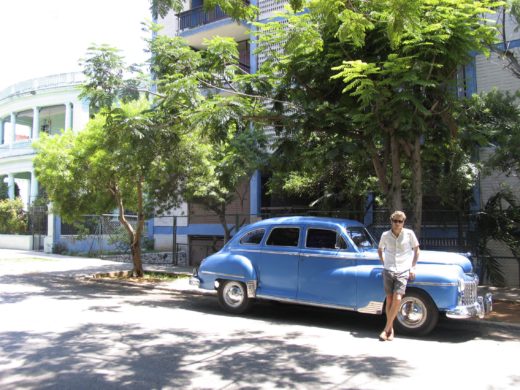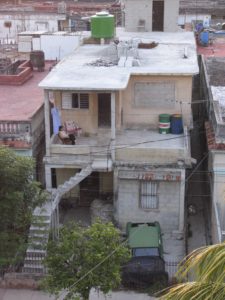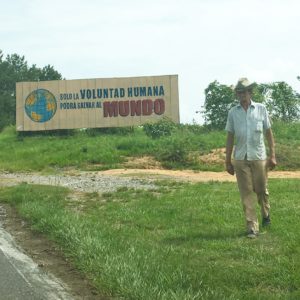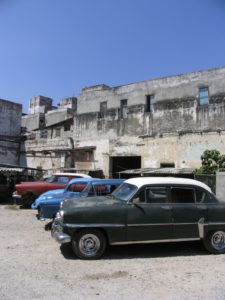
In the summer of 2008 I made my first trip to Cuba. I was scheduled to start summer school the following week, and I knew that if I skipped it I would likely have to complete it later, so whatever I did to blow off my academic obligations had to be worthwhile. Growing up in Miami, Cuba had always seemed totally off-limits. The stories that local Cubans told began fondly, but were always tainted with disdain for the Castro regime. At first, my buddy Charlie and I just played with the idea of going, but when we realized it was an actual possibility, we decided to take the next step. We bought one-way tickets to Cancun and shortly after landing there, bought tickets to Havana while still in the airport. It was exhilarating—and also totally illegal.

When Charlie and I first arrived in Havana, we instantly felt welcome. The old American cars were familiar, although they reeked of gasoline and looked as though they had been painted by brush. Locals were excited to meet American tourists because we had defied our laws to make the trip, but also because virtually everyone that we met had a cousin living in Miami. We made friends quickly and wound up hanging out with some locals, spending hours every day wandering the streets of Havana. Their economic reality meant no disposable income. One night we ended up going to an all-night rave on the beach that felt more like a Christian retreat due to the noticeable lack of drugs and alcohol.
Everything in Havana seemed like home but a little bit off and all clouded by a lingering revolutionary presence. After having spent one day at the beach of Pinar del Rio, Charlie and I passed through an armed military checkpoint on our way back to the city. Our taxi driver, noticeably anxious, leaned back and said, “If they ask, tell them you’re my cousin.” I can tell you without a doubt no one would mistake me as such. The rest of our visit, we stayed in rented rooms in homes and dilapidated apartment buildings. It was at once beautiful and incredibly sad. Everything was in some degree of advanced disrepair, but still, it felt like an abstract version of Miami—the accents, the food, the music, all reassuringly familiar.
While the idea of Americans in Cuba seems new, prior to the revolution, Havana was actually, more or less, seen as an extension of the US. Much of the infrastructure of the entertainment industry was put into place there with the help of American developers before the revolution ended. Fifth Avenue in Havana is purportedly named after the famous New York City thoroughfare, and the Tropicana in Las Vegas is named after the world famous cabaret in Havana. Sitting in the Tropicana now, it isn’t hard to picture 1940’s era American mobsters lounging in furniture custom-designed by Charles and Ray Eames, watching Nat King Cole open up the stage. The decadence of the era never left. Upon entering, patrons are handed a Cohiba Cigar and a bottle of rum.

In contrast, much of the conversation about Cuba today suggests that it will be “ruined” by American tourists. The use of that particular word, “ruined,” is a somewhat ironic way to describe its current state, because much of Havana has for a long time, in fact, been in ruins. While traveling there this summer, I met a local who told me that buildings fall down every day in Havana. He might have been exaggerating a bit, but living conditions are certainly not ideal. Even some of the graffiti that I had noticed eight years earlier was still visible on the walls that lined the streets, albeit a bit faded. Since the country’s 1959 revolution, things have been in a constant state of decline, even with some outside help from the Soviet Union—the US’s primary nemesis at the time. After the dissolution of the Soviet Union in 1989, Cuba entered its so-called “special period.” Resources were at an all-time low, and the people were on the verge of starvation and revolt once again. This culminated in a major protest in 1994 that put significant pressure on the government.
In 1997, as a way of boosting the economy, the Cuban government loosened restrictions on private business and allowed certain people to rent out rooms in their homes. These homes became known as “Casas Particulares.” During my month-long exploration of the island with Charlie back in 2008, we stayed only in these houses. The proprietors often treated us like we were their own sons, telling us not to stay out late and making sure we didn’t leave the house without eating. We found them by word of mouth—each one referring us to the next. The government also allowed for the operation of private restaurants known as “paladares.” They are often found on the rooftops of residential buildings or converted penthouses, and make the perfect place to enjoy a cool sea breeze and take in an excellent view.

This shift toward a free market economy also ushered in a black market that was fueled by Cuba’s only financial driving force: tourism. This industrial isolation and economic turmoil led to clever new forms of resourcefulness among Cuban communities. A lack of resources immediately post-revolution necessitated the development of everyday skills like mechanics and carpentry. The proof is everywhere; all it takes is to pop the hood of one of the 1950’s Chevys cruising around town. Nowadays local Cubans operating in the black market will try to hustle anything from bootleg Cohiba Cigars to Manatee flank steaks (both illegal). Any local you run into on the street will have friends with rooms for rent, friends with cars, and recommendations for restaurants that in turn give kickbacks for bringing tourists by for a meal. We met a guy on the street who offered to exchange money for us at no cost. After racking my brain trying to figure out how exactly we were being scammed, I realized his only goal was to make American friends to whom he could then offer more services.
This precarious situation has allowed local artists and artisans to prosper with the help of foreign money. The average local Cuban makes about 20 dollars a month, but if you can sell one painting to a foreigner, you’re set for a while. With surges of foreign investors in Miami, there has also been an uptick in housing prices, which has in turn meant more funding for the arts and the construction of a number of new cultural institutions. This has allowed many local cultural producers to grow within their country, rather than having to move elsewhere for better career opportunities. More traditional professions don’t have the same ‘freelance’ possibilities—imagine a local judge trying to make an extra buck. The government also allows people in creative industries to travel more freely in hopes of spreading Cuban culture throughout the world. Unlike almost everywhere else, the creative class has become uniquely elite. While on the one hand, Cuban artists have fared better than those with more traditional jobs, Cuban culture, on the other, is still their main export. Dancers, artists, and musicians have found it easy to leave the island, though many end up choosing to return.
Many of the buildings have not changed, apart from a fresh coat of paint (or not), but Cuba was never frozen in time. The people of the country have been steadily evolving and adapting to its limited conditions to make it work for them. In fact, in some ways their dire situation has proven to be relatively advantageous. In the area of ecological conservation, for example, Cuba has had a sixty-year head start, despite being hampered by a lack of resources. Problems that seem easy to solve in the US tend to become serious issues in Cuba. Two main concerns that I heard about involved an errant cow trampling seedlings in a protected area and someone dropping an anchor directly on top of a coral reef. The coral reefs are nearly untouched, and biodiversity on the island rivals that of the Amazon. Happily, it seems that the government is intent on keeping it this way. The American embargo is still in effect, and it is still illegal for foreigners to own land or businesses; nonetheless, there are plenty of companies vying to invest. However, the Cuban government is reluctant to relinquish control to outsiders. They have already turned down a number of large projects, including a bid from Google to install Wi-Fi across the entire island at no charge.
There will come a time when foreign business will be allowed in more easily and the question will be whether or not Cuba can maintain that which makes it unique. It is clear that in Miami, Cuban culture is overwhelming and has infused every aspect of life, including food, nightlife, art, and politics. Our last six mayors have been Cuban. Given the profound effect Cuban culture has had on Miami, the idea that American culture could in some way replace Cuban culture on their home turf seems unlikely. The relationships between American industrialism and that of Cuba are manifold. Our history within Cuba is as long as our history without, and our pasts and futures are therefore inextricably linked.
Emmett Moore is a Miami-based artist and sailor, and he is a terrible sailor.










